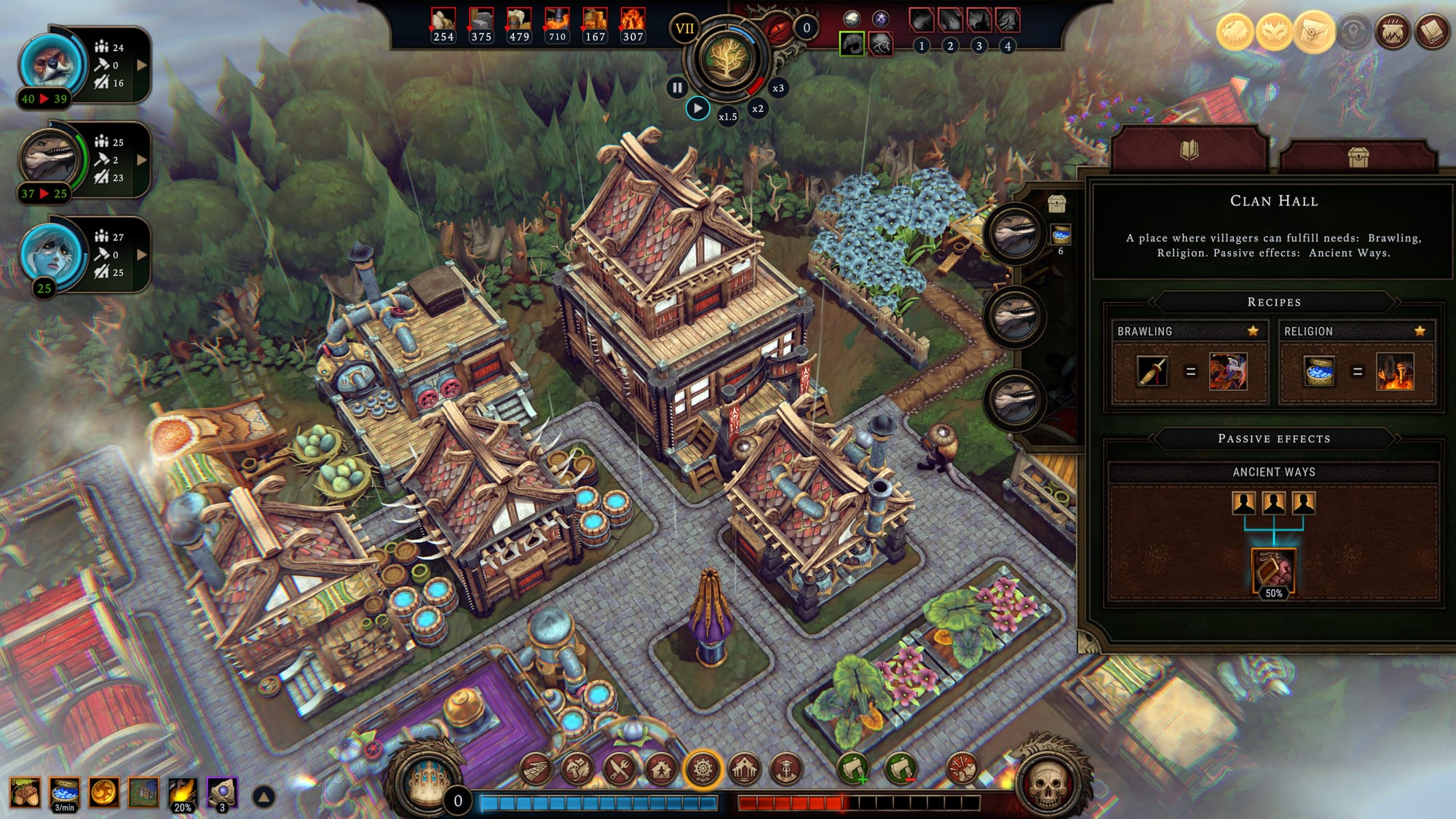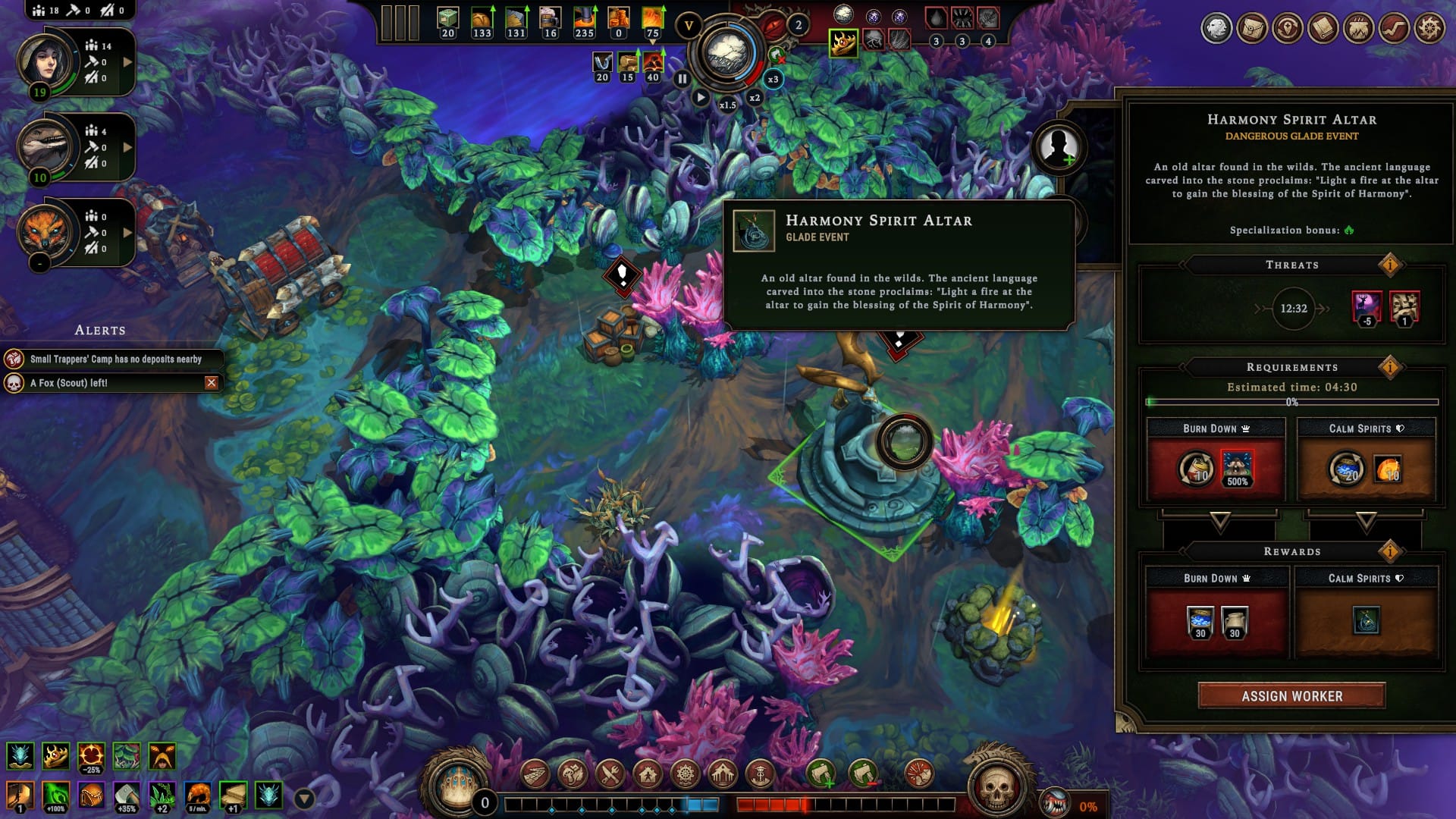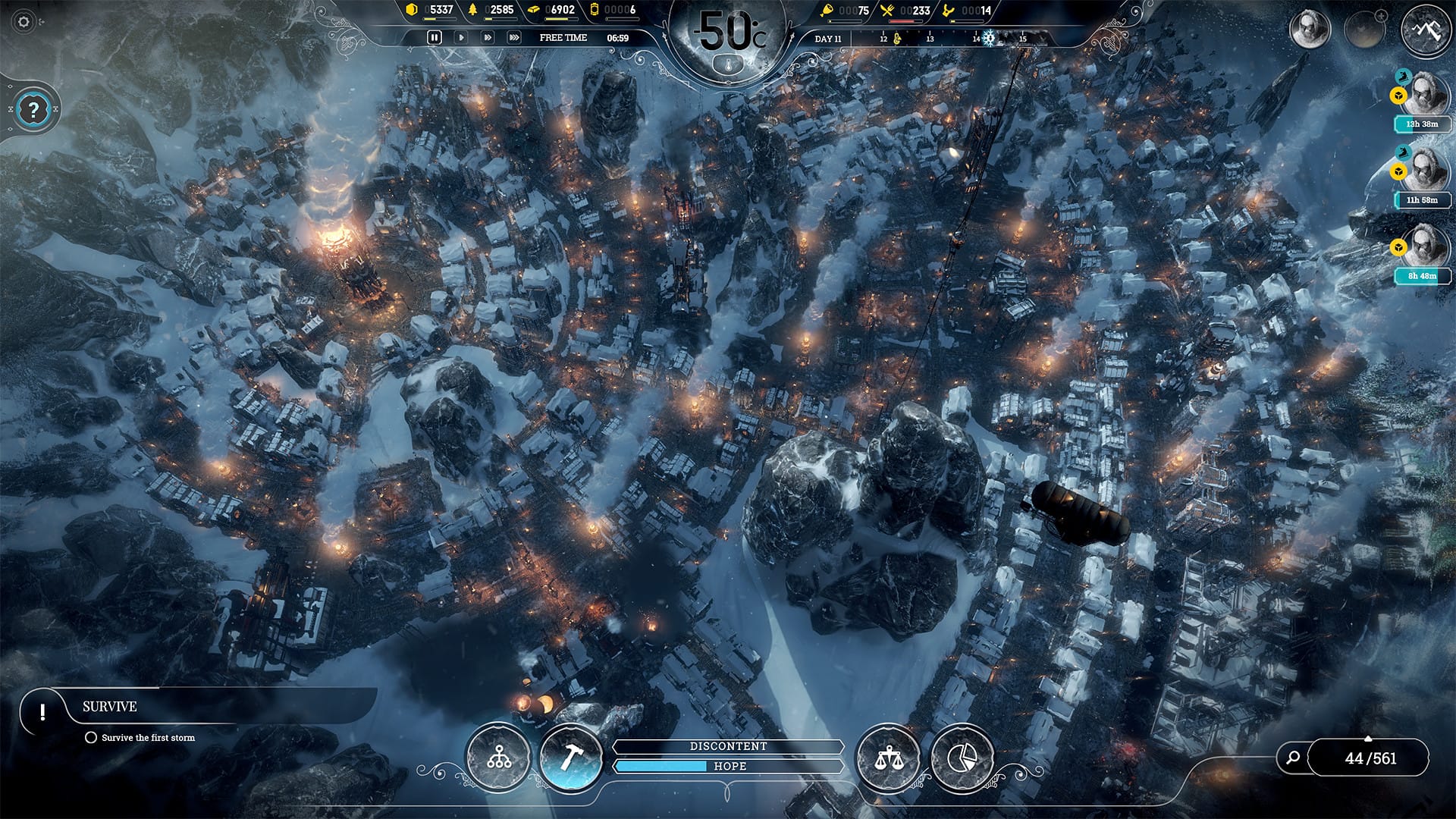You play a “citybuilder” game, the city stays built, no? That’s been the tacit agreement since at least…what, 1989? Fires, meteor strikes, alien spider mechs all notwithstanding, you did the work, and so the work (mostly) stands, for as long as you would like it to at least. That’s remained the case even in our current age of climate anxiety, where “dystopian” has become the citybuilder’s prevailing aesthetic mode. There’s Frostpunk, set in the last surviving city during a new ice age, and Endzone: A World Apart, where electricity was so scarce as to verge on magical, but both nevertheless play out as exercises in accretion. The eponymous Airborne Kingdom decamped the earth’s surface altogether—and yet even it had a floating foundation you could just keep on adding buildings to, in defiance of both Icarian precept and the laws of aerodynamics.
Only with Against the Storm, which officially released late last year to great acclaim, has one of these games truly invoked the power of an apocalyptic setting to unmake its players’ creations. In doing so, it also activated a latent, dark potential of the citybuilder genre. What, after all, does the destructive cycle of climate change represent, if not more and more opportunities to build back better?
Against the Storm is a roguelike citybuilder, you see. Roguelikes are defined by, if nothing else, their purgatorial gameplay loops, where the player is regularly forced to relinquish much of their gained ground in favor of starting over. In this case, that ground includes everything built on top of it. Think of high tide vis-a-vis sandcastles, and you’ll get the gist. For a citybuilder, this sounds almost definitionally counterproductive, but Against the Storm’s popularity — with 1 million-plus sales on Steam and the coveted “Overwhelmingly Positive” aggregate rating — shows that players aren’t troubled much by these losses. After all, a self-sustaining settlement is only a minor goal, here. Indeed, whether the player achieves one or not, Against the Storm invites them to move right on to another level, guiding the eye away from short term stability of the built environment and towards loftier measures of success. You may take this, as I initially did, to mean someday putting a stop to the climate apocalypse. But Against the Storm pitches a different vision for success. “Ask yourself,” it seems to be saying. “How can you make the storms work for you?”
That's “storms” plural: in Against the Storm, the “Storm” operates on more than one valence. The most obvious one would no doubt be the “Blightstorm,” the cataclysmic affair that arrives every 40 years or so, engulfs the world, and marks the end of the game’s roguelike calendar. When the Blightstorm arrives, your villagers must abandon their outskirt settlements and ride it out in the Smouldering City, a volcano that functions as a keep that’s safe in the storm’s eye. As a “Viceroy,” it’s the player’s job to begin resettling the surrounding wilds anew once the storm passes, searching for ancient seals that will purportedly help put a stop to this cycle of destruction. You have until the next Blightstorm to reach one, after which the process repeats.
This state of affairs seems, at least initially, to be unreservedly dire.
The player, though, ends up contending much more directly with smaller, seasonal storm varieties, such as “Drizzle,” “Clearance,” and, well, “Storm,” that rapidly cycle through as they work directly on their settlements. Raincoats are the fashion staple of the humans (along with the humanoid beavers, foxes, lizards and harpies of your villages, who scurry about foraging, mining, crafting, and collecting precipitation to power their “rainpunk” machines. Drizzle is the planting season, and also when upgrades and blueprints for new buildings get doled out. The harvest season, Clearance, is fêted on arrival with gentle musical notes and god rays. During Storm season things get a bit dicier, with heavier downpours and litany of negative effects. Regardless of the season, the rain never stops, nor does the work. In this sense, there is one storm, and though its character is ever shifting, it remains perpetual. The challenge is then about adaptability and perseverance.

The Storm as the looming void on the horizon, the end of history, and also just an ever-present thing that you have to cope with? That, at least, is certainly evocative of the perpetual dissonance of life with climate change, where we simultaneously get “more frequent severe rain events,” and also “unknown drought risk,” with deadly summers and pleasantly mild winters. It was a broad trend corresponding with rising global averages, until suddenly it was radio and TV hosts asking scientists if a specific storm was due to climate change, to which the scientists started replying: kinda? The idea of eco-anxiety is simultaneously a non-pathological response and also treatable. In modern parlance — the “new normal.”
Conventional wisdom holds that capital, in prizing steady, reliable growth, must surely detest entropy of this sort. An especially Pollyanna-ish supply-sider might even still try arguing that this is why free market solutions for climate change are on their way…well, any day now. This is where you, the Viceroy in Against the Storm, are situated, sans irony. While your nominal role is putting a stop to the Blightstorm, in practice, it seems to mostly involve trading goods and amassing wealth. Now, in one sense I think, OK fine, fair enough. If a ping pong video game was actually about achieving world peace, I'd probably expect to find out that the global order hinged on my paddle skills all along. Maybe I could suspend my disbelief in the restorative power of trickle-down economics. So I daisy-chain successful settlements together, supply to demand, demand to supply, until I’ve done enough to put an ancient seal within reach, and amassed sufficient goods to appease Neptune, or the ghost of Ronald Reagan, or whoever. (For whatever it's worth, Against the Storm did not appear in Steam's recent "Capitalism and Economy Fest” sale, for which the header art featured flying bills and Scrooge McDuck-level stacks of gold coins).
But in another sense, how “against” the storm is the Viceroy, really? This is more than a matter of the game’s bumper sticker-ready slogan of a title. (As a New Jerseyan, “Against the Storm'' immediately puts me in mind of “Stronger than the Storm,” the cringey ad campaign the Christie administration appropriated $25 million in federal Hurricane Sandy relief funding for.) They seem to have a pretty good thing going, since the demands of the storm mean they’re continually being furnished with new workers and claims just waiting to be staked. The stormwater itself is essentially liquid gold (some of it literally golden): with a few simple upgrades and for the small cost of a little ambient toxicity, it can be used to supercharge the output of almost any production line. And the Blightstorm’s cyclical resets ensure that the player, as the Viceroy from without, is always working with a clean canvas, unburdened by most of the fussier responsibilities of urban planning like maintenance, rezoning, or retrofitting. They’re positioned, in fact, like private equity, leveraging their settlements towards future gains and banking dividends in the form of upgrades and decorations for their in-game house — whether or not the roguelike venture succeeds or ends up liquidated.

One can laissez-faire les bon temps rouler in this fashion for quite a while, it turns out. After a few cycles and with a dozen or so settlements under my belt, I finished my first Bronze Ancient Seal only to find, after Blightstorming the map clean again, another Bronze Ancient Seal floating out in the forest. I completed a “Lead” Seal instead, which yielded: more Bronze and Lead Seals. (As I would eventually learn, at least six other types of seal lurked further out in the wilderness). I decided to stop what I was doing, and dug up a thread on the game’s subreddit asking if there was an ending in the works. In it, one responding user suggested:
Aside from the gameplay of the climb, the idea of locking all of the seals was big for me, because if you think about the nature of the cycle, and what it means for that world, it's incredible.
The cycle starts off at 40 years, and it's been like that for centuries. The storm itself lasts for an indeterminate amount of time, but when it's done entire biomes have changed, so you know it ain't a week or two. It drowns the whole world in blight.
How many kids are born during the storm and don't live to see the end of it? How many elderly go into the storm knowing they'll never see the other side of it? All of these villagers risking their lives have families back in the citadel. They are desperately trying to scratch out a living on the frontiers hoping to stockpile enough food to let the citadel survive.
But by the end, the cycle is over a century. People have a chance at having real lives. You're not able to save the whole world. The storm still comes. The blight still kills. But you make the whole world a better place, regardless.
It’s a pretty stirring interpretation, but one that Against the Storm doesn’t put any of its own resources towards. The more honest answer, I think, is one the same user later appended, seemingly as an afterthought: “You got a whole as (sic) Prestige climb to finish, and then the Queen's Hand challenge. That's the actual end game. YMMV on how satisfying you consider that ending.”
So there you go. The challenge adds a run-based mode with perma-death and dash more narrative flavor, but it offers a feather in the cap, not closure. Small wonder then, all told, I started to find that the Blightstorm just wasn’t weighing especially heavy on my conscience. It is, after all, just a brief spiraling effect seen from above, followed swiftly by placidity. Whatever ostensible loss of life has just occurred, according to the game’s lore, it’s more like a toilet flush than an act of God. Hell, you can even trigger it whenever you want with the push of a button if you want to re-roll the overworld map. The storm leaves no visible devastation after it recedes, either. The hexes representing individual forest biomes are not razed, but reshuffled. There would be no sign of a storm having ever visited save the fact that the half-dozen tokens representing your settlements are gone. (As a bit of in-game text describes, they strike camp before the worst sets in.)

What it does do is provide the citybuilder with a perpetually replenishing supply of empty acreage for development. This brought to mind Naomi Klein’s book The Shock Doctrine, specifically its introductory chapter, which happens to be titled “Blank is Beautiful: Three Decades of Erasing and Remaking the World.” Klein describes a phenomenon whereby disasters (be they natural or manmade) often create fertile ground for cynical profiteering. Agents of free-market capitalism, applying the military principle of “Shock and Awe” to overwhelm and cow their foes with bombastic displays of power, seize upon these crises to sweep in, making audacious land grabs and foisting privatization on the still-reeling victims. Such vultures, Klein writes, “are convinced that only a great rupture — a flood, a war, a terrorist attack — can generate the kind of vast, clean canvases they crave.” (For my money, the Christie administration’s Beachgate scandal remains the most ludicrously individualized version of this in microcosm.)
With each press of the storm button, I thought increasingly about The Shock Doctrine. I began to feel, acutely, like I was tinkering with some mail-order Junior Milton Friedman starter kit, practicing how to pave paradise and fill it with microbreweries. I was acquiring monopoly money and a taste for the ephemera of late capitalism—an endless array of proximal goals, drip-fed unlockables, and superficial rewards. I thought about the government official Klein quotes who said, in the aftermath of the 2004 tsunami, "In a cruel twist of fate, nature has presented Sri Lanka with a unique opportunity, and out of great tragedy will come a world class tourism destination,” presaging the forced relocation of coastal fisherman and the granting of their former land to corporate entities for resort construction. Or Jared Kushner, who, as I was writing this, was suggesting that Israel forcibly relocate the people of Gaza to the Negev desert, noting that “Gaza’s waterfront property could be very valuable.” (Netanyahu’s Likud, for its part, released a master plan for “Gaza 2035,” a “Gaza-Arish-Sderot Free Trade Zone,” complete with AI art that can only be read as a The World If… meme but for the elimination of Palestinians.)
This is a pretty malign thing to charge a video game about cartoon lizards and beavers with, even in metaphor, I know. Hardly any entry in the adjacent 4X genre (Explore, Expand, Exploit, Exterminate) would stand up to even the most half-assed humanitarian audit. But for most of these games, problematic genre conventions are lamentable things to mitigate or filter out through layers of abstraction. The Civilization series eventually, and somewhat ham-handedly, created a “cultural victory” condition to subvert its original focus on conquest. (Granted: one of the ways you could achieve it was by looting other civilizations’ historical artifacts, but there were at least diplomatic repercussions for doing so.) With Civilization 6’s Gathering Storm expansion, it also made natural disasters and rising sea levels the consequences of rampant industrialization, and the board game Settlers of Catan looks to emulate that feature later this year. Of the citybuilders, Frostpunk made a commendable effort to individualize its citizens and graphically illustrate the sacrifices the player was asking of them. But Against the Storm, as a work of appropriation both figuratively and literally, has no better angels.

The game is, in many ways, a doppelganger of Frostpunk (the Wolf to its Klein, if you will), cribbing liberally from the former's mechanics and conventions with little regard for the context they once operated within. Frostpunk’s iced-over settlements radiated out from their central generators, the foci about which all survival efforts hinged. Against the Storm imports these generators (here called Hearths), and deems that several buildings — especially residences — must be built within the orb of their warmth. Does the storm bring cold, too? It’s not entirely clear. Most production buildings aren’t subject to this heating requirement, nor is the settlement oriented around it. In fact, the Viceroy’s mandate is apparently to impose a grid-based system on the lands they claim, because Against the Storm’s settlements are uniformly rectilinear. And in keeping with imperial Roman form, they’re delineated by roads, which can be finished — perplexingly, considering all the rain — with copper (if I were a Viceroy, I would simply not further reduce the pervious surface area). The Fighting Pits in Frostpunk go from a somewhat weighty decision about how much violence you want to introduce to your fragile community to generic “Clan Houses” in Against the Storm, which flatly satisfy the Lizards’ need for brawling.
Uprooting these concepts from the context of their creation leaves them as empty signifiers, and in an attempt to fill them with meaning once again, Against the Storm turns towards the genre’s inherent colonialism and its ability to project ideology. Ushering it in behind the Blightstorm only compounds its potency—because historically, colonial expansion has always “uncannily syncopated the rhythms of natural disaster,” as historian Mike Davis observed in Late Victorian Holocausts. “If the southern African drought of 1877, for example, was Carnarvon’s opportunity to strike against Zulu independence, then the Ethiopian famine of 1889-91 was Crispi’s mandate to build a new Roman Empire in the Horn of Africa. Likewise Wilhelmine Germany exploited the floods and drought that devasted Shandong in the 1890s to aggressively expand its sphere of influence in North China.” These were the shock doctrine’s early adopters, and they provide the template for much of what the player gets up to in Against the Storm. The result is a work of colonial revanchism, with climate disaster providing the cover to reestablish beachheads for old hierarchies.
This content is for registered subscribers only
Register now to access "Productive Citybuilding at the End of the World".
Sign up now Already have an account? Sign in